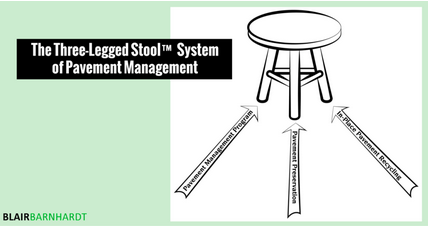 If you’re going to set up a three-legged stool™ system of pavement management and
If you’re going to set up a three-legged stool™ system of pavement management and
succeed with it, it’s basically three steps.
You’ve got:
• Pavement management as #1,
• Pavement preservation as #2,
• In-place recycling as #3.
When you marry all three of these together,you get the three-legged stool™ system of pavement management.
1. Pavement Management
First of all, many cities and counties typically have no idea how many miles of paved road they actually have. We see this firsthand. I walk this walk and talk the talk every single day. When I’m not making new curriculum for IPMA Academy or for one of our books or one of our audio or DVD sets, my consulting firm is out there on
the ground doing pavement distress evaluation day in, day out, all across this great country.
Moreover, many cities and counties have no idea of the condition of these roadways. For $0.02 per square yard, they can have a pavement distress evaluation performed, whether they get their own folks to do it in their house or hire an expert consulting firm.
Now if you do hire an expert consulting firm, I highly recommend that the consultants are selected following the guidelines laid out in the APWA Red Book, the qualifications-based selection guide. So go ahead and get that from Apwa.net if you don’t already have it. The pavement distress evaluation will help to identify the pavement type, whether it’s chipseal or micro-surfacing, hot-mix asphalt pavement or otherwise, along with the pavement condition index, the all important PCI. Now typically, the PCI has zero as undriveable at the bottom end and 100 as brand new at the top end per ASTM 6433. Now other systems may be 1 to 10 or 0 to 60; we’re
talking in the book predominantly and throughout IPMA Academy about ASTM 6433 or 0 to 100 scale with 100 being brand new. Once the PCI is in the computer software, three different types of budgets can be run.
These three scenarios are as follows:
1. A needs-based budget in the scenario the algorithms and the software will compute precisely how much money your city, your county needs each year to get your pavement network at optimum level. That’s an average network level of PCI of maybe 84 to 86. It never gets to 100; 84/86 is optimal. That is like winning the lottery, is what I usually say when we print that binder off and give it to our clients.
We say, “Unless you win the lottery, you’re never going to have enough money to go around to do everything that the software wants you to do.”
2. Next, we have target-driven scenario, and the target-driven scenario is where you go back to city council or the county commission meeting, and you say, “We’re at a network level of PCI equals 57 that we’d like to get to a 70.” So now knowing that you aspire to get to a PCI of 70, the software will actually go out and tell you how much money it will take to do that and how long it will take to do it. So again, that is a target-driven scenario.
A 30,000-foot Overview of Pavement Management:
3. Now the third is generally the budget scenario that we set up. It is where you come to us or you go to your pavement manager, and you say, “I have $5 million a year to spend, and by the way, there is a detailed little analysis in your book that will tell you how much you should be spending each year on your roads. So make sure you refer to that from time to time.” So, in the budget case scenario, you tell the program you’ve $5 million to spend; it will go out there and tell you if you’re under
funded and if your network PCI is going to drop or stay the same or go out. Based on that amount per year, you can tweak it so you can spend various amounts per year. If you have a sudden influx of money, you can run another budget scenario and add that. At this point, I must stress the importance of having a qualified staff to set up your decision tree within a computerized pavement management software platform. There’s two software programs that are used most frequently for cities and counties, and those two are MicroPAVER and StreetSaver. Both programs allow the user to spend just $1,000 or $2,000, and you’re up and running, whether you do it in-house or you hire someone to do it. They’re not expensive, very robust programs, and they can be cloud-based. In the case of MicroPAVER, it can also be on your server.
But most of the industry is heading more towards a cloud-based system with automatic updates, so you never have to worry about automatic backups; you never have to worry about a thing other than putting your data in and managing it. Both programs follow ASTM 6433 and are fully capable of doing all the aforementioned
scenarios and the decision tree setup.
Now remember, a real person has to sit down and put in all the unit prices for the decision tree setup. I will reiterate, many pavement management software programs are very sophisticated and robust, and can run multiple scenarios on multiple different types of pavement and functional class codes, but they are all only being fed thin overlay, medium overlay, and thick overlay. That in itself is a recipe for disaster as there are so many tools in the preservation and rehabilitation toolbox to repair your infrastructure.
Pavement Management Primer
6
The most common question I get is, “How much does it cost me to set all this up, Blair, and pay for the program?” So again, MicroPAVER or StreetSaver is going to cost you between $1,000 to $2,000, really depending on whether you get your GIS integrated and so forth. Typically, you’re going to spend $0.2 per sq. yard to set up your pavement management network. That’s including having a consultant to come out and rate everything with boots on the ground.
It’s going to save you, with qualified expertise setup, upwards of $10 per sq. yard. Now that’s a net savings of $9.98 no matter how you slice it. It doesn’t really cost you money, therefore, to manage your pavements; it’s actually costing you money not to manage them.
There’s training available through IPMA Academy should you choose to train your team in pavement management, thanks to the partnership between Auburn University and the International Pavement Management Association. Again, IPMA Academy’s 70 hours of the most comprehensive online training available to mankind ever created, you get your Accredited Pavement Manager certification. Now with the partnership with Auburn University, you also get the Continuing Education Credits (CEUs).
We have broken out the three modules, so you can now take one module at a time. If you so choose to put all three together, you get your APM (Accredited Pavement Manager) designation. If you’d only take one module or two modules, you get a certificate for taking that module and the requisite CEUs.
So that is #1. You’ve got your pavement management system set up. Now let’s start going in and plugging in some of the stuff into the decision tree.
2. Pavement Preservation
The second part of the three-legged stool pavement management system is pavement preservation. Now there is a multitude of preservation treatments available across this country to preserve and protect our pavement structure, so that they never fall into a state where they need to be removed and rebuilt completely. The timing of these treatments is critical, however, but the
good news is this that with the properly designed pavement management software system, your team will have the scientific proof of the proper treatments at the proper time.
Now one of the keys of the entire three-legged stool system is applying the right treatment on the right road at the right time with the right contractor and for all the right reasons, and not just because it’s an election year. An example of this might be as the PCI drops from 100 down to 77, a simple slurry, micro-surfacing or high density mineral bond treatment might be triggered for installation at that time.
This preservation type and timing is set up in the decision tree in the MicroPaver or the StreetSaver software or whatever software you’re using or you’ve selected, which we discussed earlier. Worth noting is that some of the preservation treatments also double as wearing surfaces for the in-place recycled roadways, and I’ll talk about that next.
But before we go any further, I have to reiterate the importance of what preservation is in the eyes of federal highways (FHWA) and the ADA (American Disabilities Act).
What is preservation, and what is an alteration? You see, the most recent clarifications that have been made by the U.S. Department of Justice concerns the difference between doing a job with a slurry seal
Or micro-surfacing, which could mean you spend $300,000 or $900,000. The reason for that is not just that micro costs a bit more than the slurry, but, more significantly,
choosing micro forces the hand of the city or the county official to also upgrade all of the ADA ramps and sidewalks among other ADA related improvements.
Wondering how significant this is? Well, I do Google Alerts on all of the stuff we talk about in The Book On Better Roads, and just about every week I read about
some city or county that just had their paving project double in cost because of this very subject we just discussed. One county engineer told me that one of her bucket truck drivers accidentally left the boom up on his truck at an intersection and slightly bent one of the crossbars in the signalized intersection. It cost her county half a million bucks in ADA upgrades to meet the construction compliance laws set up by the Department of Justice.
Now following is a list of some preservation products you may put into play with your city or county. Most of all the products have been used for a decade or more, some for several decades. Again, this is not meant to be an all encompassing list. A little disclaimer here: this is not meant to be an endorsement of any type of product, service, software or otherwise. We don’t roll that way here.
From the top of the curve down, we’ve got, remember, this being 100 and down to 0, and these would all fall up in the upper range of the curve, hence “top of the curve.”
We’ve got rejuvenating agents like the PASS products from Western Emulsions: rejuvenating fog seals, rejuvenating scrub seals. Then we’ve got chip seals: single, double and triple chip seals; tar and chip you may call them, other names along the way. I’ve got to point this out: Chip seals are not seal coats. Now some state DOTs refer to chip sealing as a seal coat, but a chip seal is a chip seal. A chip seal is a surface treatment; a chip seal is not a seal coat.
Then we’ve got the high density mineral bonds (HA5). We’ve
Got slurry seals; we’ve got micro-surfacing which at one time was referred to as Polymer Modified Slurry (PMs). We’ve got ultra-thin bonded wearing courses. Thin overlays, now we’re talking about the hot-mix family here, and thin overlays with RAS (Recycled Asphalt Shingles) and RAP (Recycled Asphalt Product). Mr. Gerry Huber talked about this. We were at Purdue together a couple years back, and he had a great discussion about RAS/RAP mixtures with upwards of 57% recycled product. I think there was like 18% Recycled Asphalt Shingles and 39% Recycled Asphalt Product. Also, I want to point out that Dr. Mike Heitzman from NCAT
also did a really good IPMA Academy live session for us just a while back on hot-mix asphalt thin overlays in pavement management. Again, this list above is not meant to be all inclusive. If I missed something during the recording of the session, know that there are maybe a few others out there that you are considering or your agency already currently uses. So here is where the biggest bang for your buck comes for your city or county and the third leg in the three-legged stool system of pavement management: in-place recycling.
Since the majority of our four million miles of paved roads in the USA are hot-mix asphalt pavements, we focus on the three main disciplines for hot-mix asphalt pavements, namely Hot In-place Recycling (HIR), Cold In-place Recycling (CIR), and Full-Depth Reclamation (FDR).
However, on the concrete pavement side of the rehabilitation and preservation fence, there are plenty of requisite treatments for PCC as well. One of those we discuss quite often for rehabilitation of PCC is rubblization.
3. In-Place Recycling Treatments
Following are the in-place asphalt recycling disciplines and the respective sub-disciplines. We’ve got Hot In-place Recycling with the sub-disciplines being:
surface recycling; remixing and repaving. And we’ve got the hybrid combo called Re-HEAT. Now simply speaking, the surface recycling technique involves a series of sequential heaters that heat up the old asphalt surface in-place. The train moves down the roadway one lane at a time, heating the pavement upwards of 300 degrees, adding polymer modified rejuvenating agent, then scarifying the surface to a nominal depth between one and two inches. The rejuvenated mix is then laid out with an attached screed, just like a conventional paving screed, which is attached to the back-end of the last sequential heater. The mix is compacted with a conventional hot-mix asphalt type pavement equipment. You could think about this process, the surface recycling, or scarification, as giving you a new leveling course, where wearing surfaces from the pavement preservation list, could be added.
Next, we have the remixing sub-discipline heats up the old in-situ asphalt pavements, similar to the former method I just discussed, but this time, having the ability to add upwards of 30% of new version hot-mix asphalt at the same time. Now imagine, if you will, using that 57% super-duper RAP/RAS combo that I mentioned
earlier in the session as your supplemental admixture for this remixing technique.
In this technique, the crew can do two to three inches in depth by doing sequential heating, milling, and mixing. This technique is used on all types of roads, including the Oklahoma turnpike which I think I just drove over a week ago in the Better Roads bus. In the case of the turnpike, they applied an ultra-thin bonded wearing
course as the top course or the final asphalt layer.
Now the third sub-discipline of Hot In-place Recycling (HIR) is the
repaving method. When we talk about this in class, I use the peanut butter and jelly sandwich analogy. So picture this: Take the old asphalt that gets heated and scarified, much like the first sub- discipline, with the jelly being into new pavement placed on the top of the peanut butter or the one inch of heated old pavement. Both
layers are laid out with a double screed and compacted as one new homogenous mixture. The Re-HEAT process is kind of a hybrid between the remixing and the surface recycling. It heats up about two inches of the in-situ asphalt mix and scrapes it off the road bed, picks it up and puts it into an onboard batch plant. The batch plant runs right up inside the heater unit, and the asphalt mix gets polymer modified
rejuvenating oil added to it. Nothing else is being added, per se, just the recycling agent and the old asphalt mix, but it’s getting mixed inside of a barrel which results in a really nice homogenous mixture. It now comes out behind the heater in the final preheating and heating stages, and gets put down with basically the exact same paver. It’s integral; it’s attached to the machine itself. It’s as good or better than a standard paver that you would see on a conventional hot-mix asphalt job. The mix goes down through the paver and gets laid out and compacted with conventional compaction equipment. What makes the Re-Heat a bit different is that it does not require an additional wearing surface.
With Cold In-place Recycling (CIR)you can have single unit trains, dual unit trains, and multi unit trains. The contractors are still performing partial depth reclamation and rely on you as the agency to have at least four inches of pavement depth. The contractors can strip off the entire pavement section and recycle it in-place with engineered emulsion or foamed asphalt, provided there is a good structure underneath. The CIR contractors coin this phrase “following the rock.” It’s
worth noting here that as we go through this list of in-place recycling techniques, we are also following the declining PCI ratings.
We’re following “the curve” as we go down through these treatments. While a Hot In-Place candidate pavement may have a PCI of 62, a CIR candidate may present itself as a PCI 52 and have a thicker pavement section for the contractor to deal with.
_________________________________________
That brings us to FDR (Full-Depth Reclamation) where a typical candidate selection may be a PCI 21 or less. Now the good news is whether it’s a 21 or an 11 or a 1, it’s still going to require FDR with some sort of wearing course. So don’t struggle once the pavements get down below 30 and think you have to do everything all at once, worst first. No. In fact, you should take two or three years to budget for those types of roads and make sure you have enough money in the budget to cover those costs.
Know that, with in-place options, you can do these FDR projects for a third of the cost of conventional dig out and reconstruction. There will never likely be a time when you’ll have to ever, ever, ever dig up your old road and haul it away to a landfill site. In fact, for those of you who have seen me do a live conference event, I’ve been known to get the entire audience to stand up and make that pledge with me.
FDR (Full-Depth Reclamation) can be done with mechanical stabilization, chemical stabilization. or bituminous stabilization. The pavement structure — it can be of any combination of pavement, thickness, granular or dirt — as a requisite treatment will take care of most every situation you may have. Again, experts know to go out in the field and get proper mixed designs and soil samples, so they can align the right treatment with the right road at the right time for the right reason with the right contractor. At times, soil stabilization can be used in conjunction with the FDR to take care of the very worst case scenarios. I think back to the 30 miles in Natchez Trace Parkway that we did for Federal Highways. We took a full advantage of all the treatments that we talked about today with FDR and soil stabilization.
Note, this in-place method is a fraction of the cost of conventional undercut and provides the same or better surface life, probably the biggest no-brainer of all time.
For more information on any of the above, please refer to your copy of “The Book On Better Roads”.
Wherever you go, thanks for reading the Pavement Management Primer. Hope to see you real soon.
Blair Barnhardt, signing off.




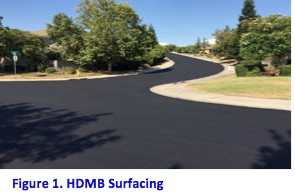 Figure 1. HDMB Surfacing
Figure 1. HDMB Surfacing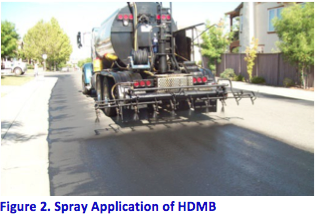 Figure 2. Spray Application of HDMB
Figure 2. Spray Application of HDMB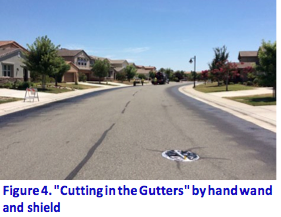 Figure 3. Valve Covers Masked Before Spray Application of HDMB
Figure 3. Valve Covers Masked Before Spray Application of HDMB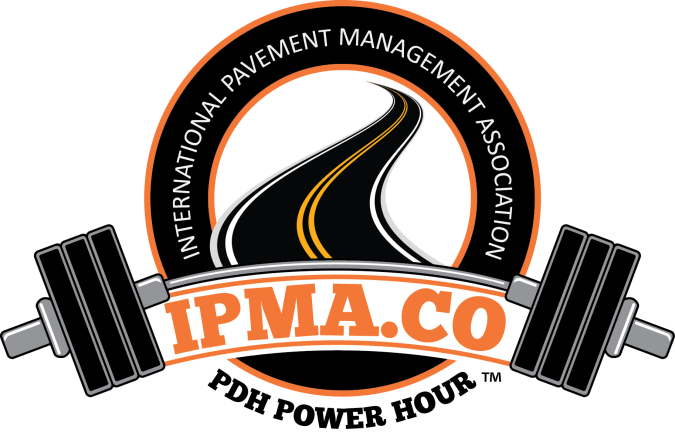


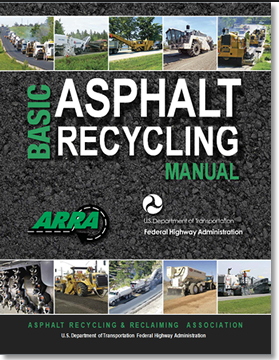

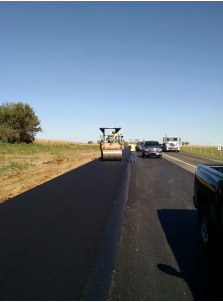
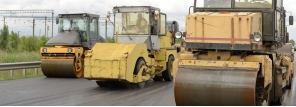






 404-594-8819
404-594-8819 If you’re going to set up a three-legged stool™ system of pavement management and
If you’re going to set up a three-legged stool™ system of pavement management and
